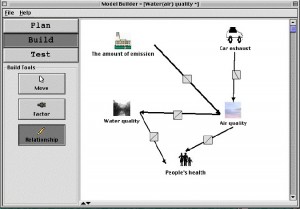I think a common failing we make in teaching mathematics is to fail to remember mathematics is about representing knowledge in a special way. We forget there are ways other than numbers and symbols and charts to represent the knowledge. Technology has allowed us many ways to represent knowledge not possible in times past. Digital models are one particular way we can now represent our knowledge – using model aids in visualizing information.
A model is a representation of an object, event, process or a system (Gilber &Boulter, 1998, as quoted by Zhang, Liue & Krajcik, 2006). A mental model is a person’s internal cognitive representation built through environmental, community, technological and artifact interactions (Khan, 2007). The goal of teaching is then to cause learners to build and revise their mental models so they better represent the object, event, process, or system of interest. Computer modeling tools have been shown to cause learners to construct or revise their mental models (Schwarz, Meyer & Sharma, 2007). Learning mathematics should then be enhanced and aided if learners use computer modeling tools. Models are mostly visual tools. They have the affordance of slowing down, or speeding up, or magnifying, or reducing the object, event, process, or system so the learner can build a meaningful and useful mental model.
The visual representation of information contained in a model is fundamental in creating or modifying the learner’s mental model, because that too, being a model, is inherently an internal vision of what is modeled. Because of this, misconceptions are challenging for learners to recognize, because they may be confusing the actual object, event, process, or system with their mental model. This makes collaboration and communication with their peers and their teacher important so the learner can be exposed to various descriptions of not only the phenomena in question, but also to the mental models of others.
Model-It allows students to engage in cognitive strategies such as analyzing, relational reasoning, synthesizing, testing and debugging (Zhang, Liue & Krajcik, 2006). This software assists student’s visualization of challenging phenomena because it aids construction or revision of mental models by visually linking together relationships between components of the phenomena. This software could be included in many units in Mathematics and Science, but especially in areas where there are definite relationships intertwining the concepts. As with all digital technology that purports to improve student learning Model-It must be embedded with solid pedagogy that actively involves the learner and it should be used in authentic learning situations with the teacher guiding and scaffolding the learner.
One specific area where Model-It could be made use of is in climate change, an area of popular concern, and part of the BC Science 10 curriculum. Other area I see myself making use of Model-It is in Surface Area/Volume issues, Food-Webs, and ecosystems Biology. As my practice evolves and I see the need for more information visualization activities for learners, I see more the value of tools like Model-It, which may not be glitzy and glamorous, but gets the job done.
Khan, S. (2007). Model-based inquiries in chemistry. Science Education, 91(6), 877-905.
Schwarz, C., Meyer, J. & Sharma, A. (2007). Technology, pedagogy, and epistemology: Opportunities and challenges of using computer modeling and simulation tools in elementary science methods. Journal of Science Teacher Education, 18, 243-269.
Zhang,B., Liue,X., & Krajcik, J.S. (2006). Expert models and modeling processes associated with a computer-modeling tool. Science Education, 90, 579-604.
